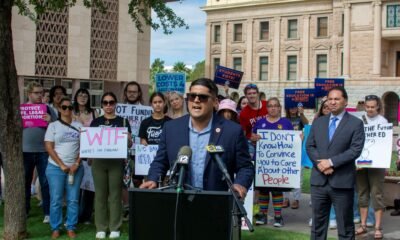Medicare
Urgent Action Needed: The Social Security Crisis Looms

By Dr. Thomas Patterson |
The future of Social Security and Medicare has become increasingly precarious, signaling a looming fiscal crisis that politicians can no longer ignore. While solutions exist, they are complex and politically sensitive, with options diminishing as urgency grows.
Any suggestion of reform often meets fierce resistance from powerful senior advocacy groups, including AARP. Those who dare to propose changes regularly face backlash, effectively preserving the status quo. The reality, however, is stark: Social Security, a government-administered defined-benefit program funded by payroll taxes, is projected to exhaust its funds within nine years, necessitating a 23% cut in benefits if no action is taken.
Furthermore, the deficits in Social Security and Medicare represent a significant share of the anticipated future federal debt. Politicians who promise to protect these programs are often merely safeguarding their political interests rather than addressing the underlying issues.
Three primary challenges jeopardize the system: elevated benefit levels, inadequate payroll taxes, and increased longevity of retirees. In the past, surpluses were diverted to cover other governmental costs, leaving a troubling gap in the Social Security trust fund.
Proposals to reduce benefits for high earners are met with outrage, often characterized as harmful to the elderly. Conversely, raising payroll taxes poses its own political dangers, with estimates suggesting a need for a 25% increase to stabilize the system post-insolvency.
With the fiscal health of the Social Security trust unable to generate income, the focus shifts toward the contentious proposal of shortening retirement lengths. Such discussions are fraught with public dissent, as demonstrated by protests worldwide.
It’s important to consider that when Social Security was launched in 1935, life expectancy was only 63. Today, that figure has risen to nearly 80, heavily skewing the worker-to-retiree ratio from 16 to 3. This shift creates a structure reminiscent of a Ponzi scheme, where current workers’ contributions are allocated solely to today’s retirees.
The concept of retirement, once a rarity in human history, is now widely accepted. Yet, even a modest delay in retirement, such as an additional two years, faces vehement opposition due in part to an ingrained expectation of government support.
While today’s jobs are generally less physically demanding, many retirees find fulfillment and purpose in continued work. Notably, accommodations are already in place for more strenuous careers, such as in law enforcement and military service.
The approach of maintaining the status quo is increasingly untenable. A prior reform proposal by former President George Bush, which was dismissed and criticized, promised workers the potential for three times their current income in retirement savings by now. The time for substantive change has come, compelling us to consider delaying retirement or facing significant program reductions.
Dr. Thomas Patterson, previously chairman of the Goldwater Institute and a former Arizona State senator, underscores the urgency of these discussions following a long political career and ongoing interest in educational reforms.


















